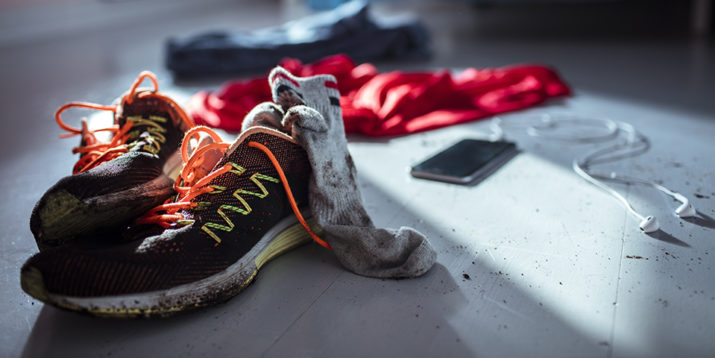How to Get Rid of Athlete’s Foot for Good

You’ve been hitting your workouts harder than ever, but now your feet are red, swollen, and itchy.
If you’ve been working up a sweat, you might have athlete’s foot.
What is athlete’s foot exactly?
It’s a fungal infection that’s annoying yet totally treatable.
“Fungal infection is one of the most common things we see as podiatrists,” explains Marion Yau, a podiatrist known as Miss Foot Fixer on YouTube.
No one is immune; she sees this infection in both adults and children.
Prevalent among gym-goers, athlete’s foot can also happen to those who work out at home.
Here’s what you need to know about this common infection and how to banish it for good.
What Is Athlete’s Foot?
Athlete’s foot is a fungal skin infection caused by mold, yeast, or a type of fungi called dermatophytes, explains Yau.
Also called tinea pedis, athlete’s foot “is a superficial fungal infection of the foot that usually affects the toe webs and sides of the feet,” adds Dr. Michelle E. Park, M.D., a dermatologist at Washington Square Dermatology.
It’s so common, she says, that “over 70% of the population can be affected in their lifetime.”
Athlete’s foot can cause the skin to “become red, swollen, itchy, and inflamed,” says Yau.
It will also get dry and flaky.
What Causes Athlete’s Foot?
Our skin naturally has bacteria and fungus living on it, and our feet are no exception, says Yau.
Those microbes usually aren’t a problem, except when our skin can’t keep them from getting past the outer layer.
“When there’s a break in the skin, the fungus gets into the foot and causes these symptoms,” she explains.
Unfortunately, our feet are like a five-star retreat for fungi.
“Fungus loves warm, humid environments,” explains Dr. Park, “therefore the foot, which gets sweaty and hot, is a common place to be affected.”
How to Get Rid of Athlete’s Foot
Athlete’s foot is, thankfully, easy to treat.
“Topical antifungals will treat athlete’s foot,” says Dr. Park. These products are readily accessible, “available over the counter as cream or powder, or by prescription,” she adds.
Don’t just treat it once and stop, though.
“It takes around 28 days to get rid of a fungal skin infection properly,” explains Yau.
That’s because 28 days is how long your skin takes to regenerate.
If your athlete’s foot doesn’t get better or gets worse, Dr. Park says it’s time to see a healthcare professional.
“There are other red, scaly inflammatory conditions that can look like athlete’s foot, so you should get a proper evaluation if there is no improvement,” she explains.
How to Prevent Athlete’s Foot
Taking care of your feet and keeping them dry is key to preventing athlete’s foot.
“Change socks often, so they don’t keep getting wet and sweaty,” suggests Dr. Park, “and buy shoes that keep your feet more ventilated as opposed to trapping heat.”
But you also need to think about where you got it, says Yau.
If you have an idea of where you picked it up in your home, she suggests a targeted deep clean of that area to prevent future infection using an antifungal disinfectant.
You might have to throw out affected shoes if they caused the condition.
But, she adds, you can also consider a UV-sanitation system.
If you got it at the gym or a yoga studio, avoid going barefoot and wear flip-flops in the shower and into the studio.


